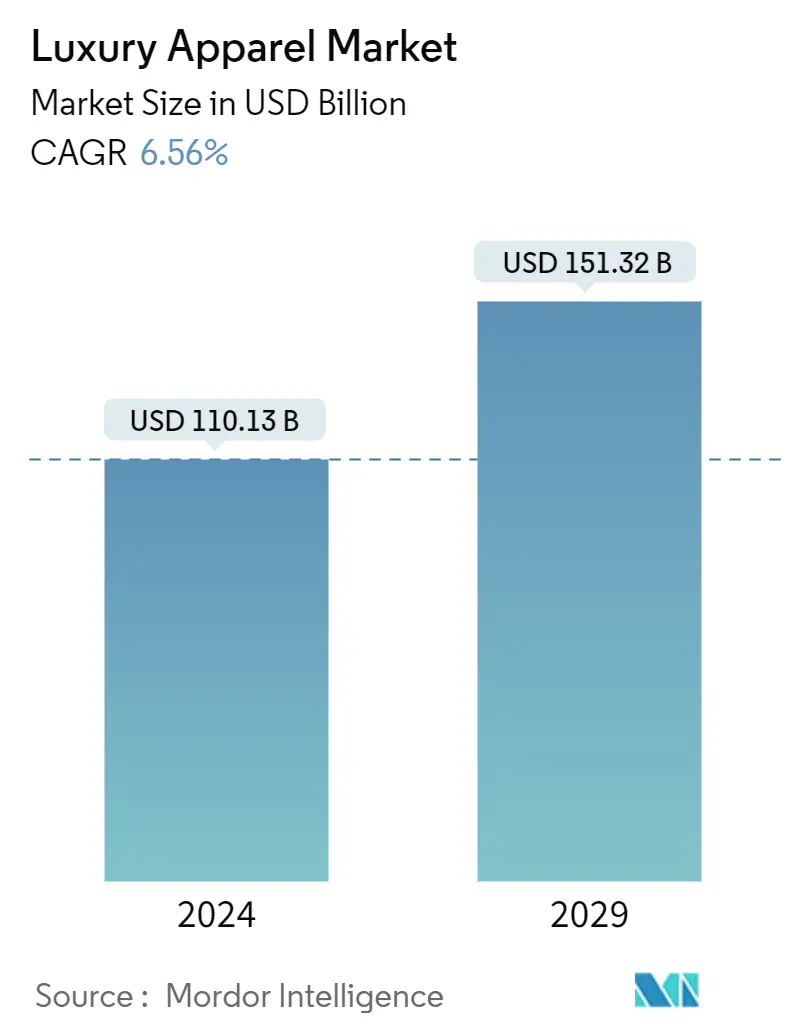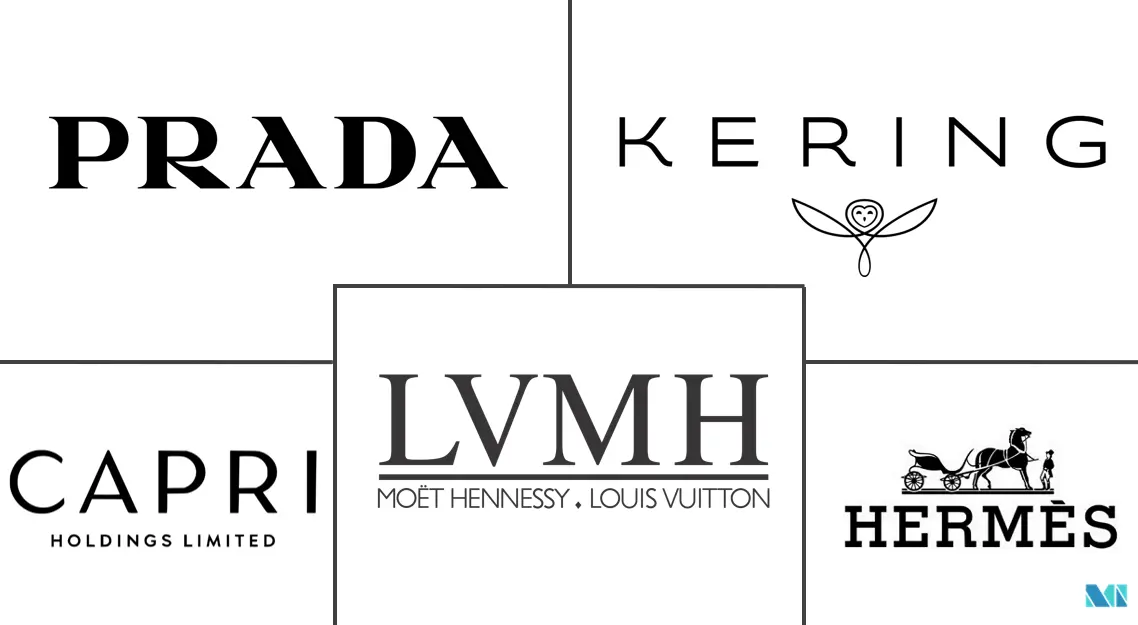Market Size of Luxury Apparel Industry

| Study Period | 2019 - 2029 |
| Market Size (2024) | USD 110.13 Billion |
| Market Size (2029) | USD 151.32 Billion |
| CAGR (2024 - 2029) | 6.56 % |
| Fastest Growing Market | Asia-Pacific |
| Largest Market | Europe |
Major Players
*Disclaimer: Major Players sorted in no particular order |
Luxury Apparel Market Analysis
The Luxury Apparel Market size is estimated at USD 110.13 billion in 2024, and is expected to reach USD 151.32 billion by 2029, growing at a CAGR of 6.56% during the forecast period (2024-2029).
Increasing communication between consumers and key players through social media platforms and online retail stores drives the latest trendy luxury apparel sales. The rise in online transactions has supported the market growth of luxury apparel over the last few years. Consumer-specific attractive promotions and advertising through magazines and social media influence the sales of luxury apparel, as nearly half of the buying decisions are majorly influenced by what consumers see or hear from offline and online platforms.
- Luxury apparel is mainly considered a status symbol for individuals and drives discretionary spending among consumers with high purchasing power. The increasing popularity of luxury apparel among millennials is driving market growth as they are more likely to be caused by the latest fashion trends than other consumer groups. Improvement in digital marketing and a rise in the use of digital media in developing economies for product marketing has been playing a pivotal role in driving the luxury apparel market's growth over the last few years.
- The improving supply chain and distribution of luxury apparel have also been driving the market studied. For example, in December 2021, Saudi Arabia's General Authority for Competition approved the joint venture between G Distribution B.V and Al Rubaiyat Co. for Industry & Trade Holding to sell and distribute Gucci products in the Kingdom. During the review period, LVHM also launched its multi-brand website to increase its accessibility among consumers.
- Moreover, premium brands are also tapping into the growing demand for modest wear across countries like the United Arab Emirates, Saudi Arabia, and others which are gaining traction among consumers willing to address both spiritual and stylistic requirements. Globally, the modest fashion industry has reached to USD 277 billion mark (State of the Global Islamic Economy Report 2020/21), with Saudi Arabia representing one of the significant market shares. This is aided by the country's robust modern retailing, the demand for global brands, and the growing Muslim population, creating a lucrative space for luxury brands.
- Recently, in 2022, Gucci launched its Nojum - a modest collection explicitly designed for the unostentatious needs of the Middle East, including Saudi Arabia. Such innovations have been driving the market studied.
Luxury Apparel Industry Segmentation
Luxury clothes are usually fashionable, trendy or high class, and expensive. Brands not only focus on providing the latest looks but also cater to cultural trends and street culture to attract different kinds of consumers.
The scope of the global luxury apparel market includes segmentation of the market based on type, end-user, distribution channel, and geography. Based on type, the market has been segmented into upper wear, lower wear, and innerwear. Based on the end user, the market is segmented into men, women, and children. Further, the market covers offline and online distribution channels based on the distribution channel. The market is studied thoroughly for different countries in regions worldwide, including North America, Europe, Asia-Pacific, South America, Middle East, and Africa.
For each segment, the market sizing and forecasts have been done based on value (in USD million).
| Type | |
| Upperwear | |
| Lowerwear | |
| Innerwear |
| End User | |
| Men | |
| Women | |
| Children |
| Distribution Channel | |
| Offline Channel | |
| Online Channel |
| Geography | |||||||||
| |||||||||
| |||||||||
| |||||||||
| |||||||||
|
Luxury Apparel Market Size Summary
The luxury fashion market is experiencing significant growth, driven by increasing consumer engagement through social media and online retail platforms. This digital shift has facilitated the rise in luxury apparel sales, as consumers are influenced by targeted promotions and advertisements across various channels. Luxury apparel is often seen as a status symbol, encouraging discretionary spending among affluent consumers, particularly millennials who are more attuned to the latest fashion trends. The market's expansion is further supported by advancements in digital marketing and the strategic use of digital media in emerging economies. Improved supply chain and distribution networks, such as joint ventures and multi-brand websites, have also contributed to the market's growth, enabling brands to reach a broader audience.
The convenience of e-commerce has been a major factor in the market's expansion, offering consumers the ability to shop anytime and access a wide variety of luxury apparel and accessories. Online platforms have enhanced the shopping experience by providing more options and ensuring security and reliability in transactions. The rise of direct-to-consumer platforms has addressed concerns over product authenticity, with brands launching their own websites to assure quality. Europe and North America remain key regions for luxury apparel, with European brands leading the market. Prominent players like LVMH, Prada, and Hermès dominate the industry, leveraging robust marketing strategies to maintain consumer loyalty in a competitive landscape.
Luxury Apparel Market Size - Table of Contents
-
1. MARKET DYNAMICS
-
1.1 Market Drivers
-
1.2 Market Restraints
-
1.3 Porter's Five Forces Analysis
-
1.3.1 Threat of New Entrants
-
1.3.2 Bargaining Power of Buyers/Consumers
-
1.3.3 Bargaining Power of Suppliers
-
1.3.4 Threat of Substitute Products
-
1.3.5 Intensity of Competitive Rivalry
-
-
-
2. MARKET SEGMENTATION
-
2.1 Type
-
2.1.1 Upperwear
-
2.1.2 Lowerwear
-
2.1.3 Innerwear
-
-
2.2 End User
-
2.2.1 Men
-
2.2.2 Women
-
2.2.3 Children
-
-
2.3 Distribution Channel
-
2.3.1 Offline Channel
-
2.3.2 Online Channel
-
-
2.4 Geography
-
2.4.1 North America
-
2.4.1.1 United States
-
2.4.1.2 Canada
-
2.4.1.3 Mexico
-
2.4.1.4 Rest of North America
-
-
2.4.2 Europe
-
2.4.2.1 United Kingdom
-
2.4.2.2 Germany
-
2.4.2.3 France
-
2.4.2.4 Italy
-
2.4.2.5 Spain
-
2.4.2.6 Russia
-
2.4.2.7 Rest of Europe
-
-
2.4.3 Asia-Pacific
-
2.4.3.1 China
-
2.4.3.2 Japan
-
2.4.3.3 India
-
2.4.3.4 Australia
-
2.4.3.5 Rest of Asia-Pacific
-
-
2.4.4 South America
-
2.4.4.1 Brazil
-
2.4.4.2 Argentina
-
2.4.4.3 Rest of South America
-
-
2.4.5 Middle-East and Africa
-
2.4.5.1 South Africa
-
2.4.5.2 United Arab Emirates
-
2.4.5.3 Rest of Middle-East and Africa
-
-
-
Luxury Apparel Market Size FAQs
How big is the Luxury Apparel Market?
The Luxury Apparel Market size is expected to reach USD 110.13 billion in 2024 and grow at a CAGR of 6.56% to reach USD 151.32 billion by 2029.
What is the current Luxury Apparel Market size?
In 2024, the Luxury Apparel Market size is expected to reach USD 110.13 billion.

